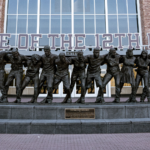What’s with B?
Baylor. Bears. Baptists.
Mercer. Bears. Baptists.
Belmont. Bruins. Baptists (no longer technically, but still).
Back to the Baylor Bears – home to Heisman Trophy winner Robert Griffin III. Home to the women’s basketball national champions. Now home to major NCAA violations in its men’s and women’s basketball programs.
And home to Baptists.
Baylor traces its origins to 1845 and the Republic of Texas, which chartered the Baptist-backed institution.
Located in Waco, Baylor has an undergraduate enrollment over 12,000. Its alumni include Michael Johnson, Olympic gold medalist in track; Ann Richards, former Texas governor; and Robert Parham, executive director of the Baptist Center for Ethics.
Baylor has captured headlines in the last year for its athletics success. Ten of its teams were ranked nationally between November 2011 and January 2012, noted a recent New York Times article about Baylor athletics.
The article quoted Baylor Regent Bobby Jones: “We like to use biblical analogies, and this is a year of biblical proportions. As we would say in Christendom, it’s like an early rapture. We spent 40 years wandering the wilderness. I hope this is our exit.”
Baylor joined the Big 12 Conference in 1996. In 1995, the Times noted, Baylor’s athletic budget topped out at $7.5 million.
The Atlantic followed up on the Times article and included an athletic budget snapshot of Baylor from the Department of Education’s records.
Now Baylor’s athletic budget stands at $60 million, about $14 million of which is spent on football.
Baylor alumnus DraytonMcLane, former owner of the Houston Astros, recently gave an undisclosed sum to Baylor for its new on-campus football stadium, estimated to cost about $300 million.
A Baylor pressrelease indicated the gift was the largest capital gift in Baylor’s history.
“We recognize that we are living in a remarkable time in the history of Baylor athletics, and we are blessed to have loyal, courageous and generous friends in Elizabeth and Drayton McLane, and their family, who have stepped forward to encourage all of us to take hold of a rare opportunity for our football program,” said Baylor President Ken Starr in the release. “Their significant leadership gift will secure Baylor’s position among the nation’s elite collegiate athletics programs.”
That Baylor athletics raised $95 million from 2005-10, according to the Times, is no small feat, especially given the scandal that rocked the Baylor men’s basketball team in 2003.
The murder of one player by another led to the departures of the head coach and the athletic director.
Enter Bob Beaudine, chief executive of the executive search firm Eastman & Beaudine.
Beaudine characterized his directive from Baylor to fill the vacant positions as follows: “Find two people who could say, ‘Jesus Christ is my lord and savior … and I can win the Big 12 championship.'”
Baylor men’s basketball advanced to the Elite 8 in the 2012 NCAA tournament, where it lost to eventual champion Kentucky.
Head coach Scott Drew has drawn criticism for his recruiting strategies and tactics, which account for part of Baylor’s recently revealed violations.
Despite Baylor’s huge expenditures, success on the athletic stage isn’t guaranteed. And perhaps that’s not even the point.
“[M]aybe we should be concerned less for Baylor, and more for the schools that try to imitate them,” wrote Jordan Weissmann in the Atlantic. “Let’s say the Bears have found the recipe for a winning sports program that will one day be able to mostly support itself, even after its massive capital expenses. Not every university will be so lucky.”
“A landmark study commissioned by the NCAA found schools that increased their spending on athletics didn’t necessarily win more games,” Weissmann continued. “It also found that teams which improve their records don’t necessarily generate more revenue. Building a successful team that covers its costs, in other words, is supremely difficult.”
To put Baylor’s athletic expenses in perspective, consider the athletics budgets of other Baptist-affiliated schools. (All the following figures were pulled from the same database accessed by the Atlantic.)
Take Shorter University in Rome, Ga., which counts roughly 1,400 undergraduates and more than $7 million in the athletics budget for its Hawks.
The Carson-Newman Eagles get $4.5 million in athletic spending for the 1,600 undergraduates at Carson-Newman College in Jefferson City, Tenn.
Campbellsville University in Campbellsville, Ky., fields the Fighting Camels. They enroll roughly 1,800 undergraduates and budget $5.7 million for athletics.
Campbell University in Buies Creek, N.C., is roughly twice the size, both in enrollment and athletic spending.
The Huskies from Houston Baptist get $8.6 million in athletic spending. HBU’s undergraduate enrollment: about 2,000.
Samford University in Birmingham, Ala., enrolls roughly 2,700 undergraduates. Its athletic budget: a little over $14 million.
Mercer University in Macon, Ga., with about 3,700 undergraduates, spends just over $8 million on Bear athletics. In 2007 Mercer created TheMercerAthleticFoundation as a fundraising wing for athletics.
“Members of the Foundation have raised funds that have been used to hire a full-time strength and conditioning coach, to enhance recruiting budgets, to provide additional scholarships and to increase salaries to help attract and retain outstanding coaches,” according to the Mercer Athletics website.
Belmont University in Nashville, Tenn., with roughly 4,200 undergraduates, budgets more than $9 million for athletics. Belmont formally ended its relationship with the Tennessee Baptist Convention in 2007.
Wake Forest University in Winston-Salem, N.C., enrolls a few more undergraduates (4,600) than Belmont, but WFU budgets roughly $42 million for athletics.
Wake Forest declined comment for this story, with an athletic department representative saying WFU had not been a Baptist-affiliated university since 1986 and, as a private university, normally does not discuss budget matters.
Wake Forest goes by the nickname “Demon Deacons,” which entered usage in the 1920s. Previously, school nicknames were “The Old Gold & Black” or the “Baptists.”
WFU still maintains a divinity school with a Professor of Baptist Studies.
“In recent years, the Demon Deacons have won national championships in field hockey (three times) and men’s soccer, achieved a No. 1 ranking in men’s basketball and played in three football bowl games, including the Orange Bowl,” reads the WFU athletics website.
And these are just the current and historically Baptist-affiliated institutions. There are more Baptists than you could shake a stick at in Austin, where the University of Texas (approximately 35,000 undergraduates) manages an athletics budget north of $125 million.
Ditto for Tuscaloosa, where the University of Alabama budgets $92 million for sports and enrolls roughly 22,000 undergraduates.
Another university with that many undergraduates: Liberty University in Lynchburg, Va. Its Flames carry Jerry Falwell’s torch – and spend almost $20 million annually on athletics.
CliffVaughn is managing editor and media producer for EthicsDaily.com. Disclosure: Vaughn holds season tickets for Belmont Bruins basketball.




